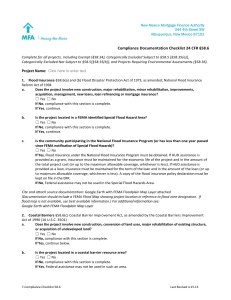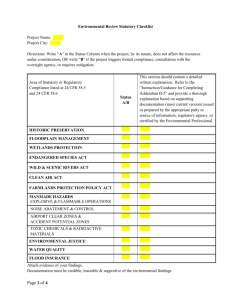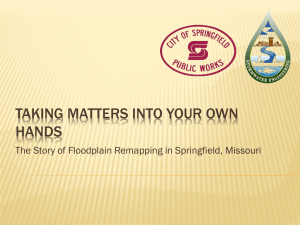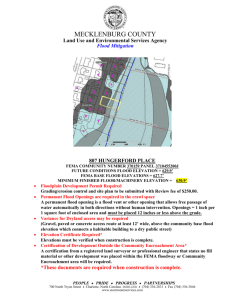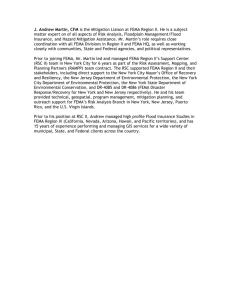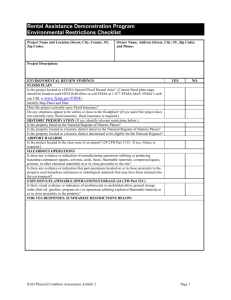Compliance Documentation Checklist
advertisement
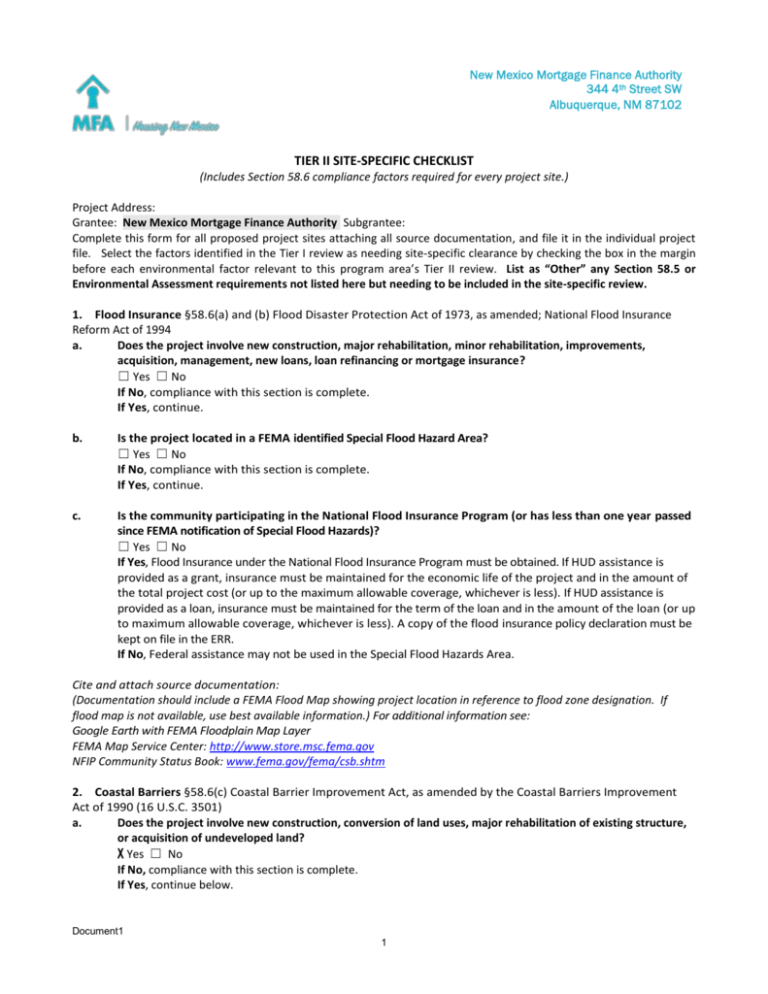
New Mexico Mortgage Finance Authority 344 4th Street SW Albuquerque, NM 87102 TIER II SITE-SPECIFIC CHECKLIST (Includes Section 58.6 compliance factors required for every project site.) Project Address: Grantee: New Mexico Mortgage Finance Authority Subgrantee: Complete this form for all proposed project sites attaching all source documentation, and file it in the individual project file. Select the factors identified in the Tier I review as needing site-specific clearance by checking the box in the margin before each environmental factor relevant to this program area’s Tier II review. List as “Other” any Section 58.5 or Environmental Assessment requirements not listed here but needing to be included in the site-specific review. 1. Flood Insurance §58.6(a) and (b) Flood Disaster Protection Act of 1973, as amended; National Flood Insurance Reform Act of 1994 a. Does the project involve new construction, major rehabilitation, minor rehabilitation, improvements, acquisition, management, new loans, loan refinancing or mortgage insurance? ☐ Yes ☐ No If No, compliance with this section is complete. If Yes, continue. b. Is the project located in a FEMA identified Special Flood Hazard Area? ☐ Yes ☐ No If No, compliance with this section is complete. If Yes, continue. c. Is the community participating in the National Flood Insurance Program (or has less than one year passed since FEMA notification of Special Flood Hazards)? ☐ Yes ☐ No If Yes, Flood Insurance under the National Flood Insurance Program must be obtained. If HUD assistance is provided as a grant, insurance must be maintained for the economic life of the project and in the amount of the total project cost (or up to the maximum allowable coverage, whichever is less). If HUD assistance is provided as a loan, insurance must be maintained for the term of the loan and in the amount of the loan (or up to maximum allowable coverage, whichever is less). A copy of the flood insurance policy declaration must be kept on file in the ERR. If No, Federal assistance may not be used in the Special Flood Hazards Area. Cite and attach source documentation: (Documentation should include a FEMA Flood Map showing project location in reference to flood zone designation. If flood map is not available, use best available information.) For additional information see: Google Earth with FEMA Floodplain Map Layer FEMA Map Service Center: http://www.store.msc.fema.gov NFIP Community Status Book: www.fema.gov/fema/csb.shtm 2. Coastal Barriers §58.6(c) Coastal Barrier Improvement Act, as amended by the Coastal Barriers Improvement Act of 1990 (16 U.S.C. 3501) a. Does the project involve new construction, conversion of land uses, major rehabilitation of existing structure, or acquisition of undeveloped land? X Yes ☐ No If No, compliance with this section is complete. If Yes, continue below. Document1 1 b. Is the project located in a coastal barrier resource area? ☐ Yes ☒ No If No, compliance with this section is complete. If Yes, Federal assistance may not be used in such an area. Cite and attach source documentation: New Mexico is a landlocked state, bordered by Colorado, Oklahoma, Texas, Mexico and Arizona. The nearest coast is in Mexico, over 200 miles from the southwest corner of New Mexico. Refer to any map of the United States (Documentation should include map (e.g. Google Earth) noting project distance from Coastal Barrier Resources.) For more information see: CBRS maps on US FWS and FEMA websites: http://www.FWS.gov/CBRA/ and http://www.FWS.gov/CBRA/Maps/index.html 3. a. b. Runway Clear Zone §58.6(d) Runway Clear Zones and Clear Zones [24 CFR §51.303(a) (3)] Does the project involve the sale or purchase of existing property? ☐ Yes ☐ No If No, compliance with this section is complete. If yes, continue below. Is the project located within 2,500 feet of the end of a civil airport runway (Civil Airport’s Runway Clear Zone) or within 15,000 feet of the end of a military runway (Military Airfield’s Clear Zone)? ☐ Yes ☐ No If No, compliance with this section is complete. If Yes, Notice must be provided to buyer. The notice must advise the buyer that the property is in a Runway Clear Zone or Clear Zone, what the implications of such a location are, and that there is a possibility that the property may, at a later date, be acquired by the airport operator. The buyer must sign a statement acknowledging receipt of this information, and a copy of the signed notice must be maintained in this ERR. Cite and attach source document: Nearest airport is _____miles away in___________________, NM (Map indicating project site in proximity to end of runway) For more information see: Airport Information: http://www.airnav.com/airports/ and HUD Airport Hazards Q&A: http://portal.hud.gov/hudportal/HUD?src=/program_offices/comm_planning/environment/review/qa/airport SECTION 58.5 COMPLIANCE FACTORS: (58.5 factors not listed here, but requiring a Tier II review should be identified and cleared in the “Other” section, below. HISTORIC PRESERVATION Does the project involve a property 50 years or older, demolition, or new construction? No. STOP here; compliance established. Yes. Consult with SHPO. Date SHPO review is completed: __________. Attach Historic Response Sheet. NOISE ABATEMENT AND CONTROL Is the project located within 1000 ft. of a busy road or highway, 3000 ft. of a railroad, 5 miles of a civil airport or 15 miles of a military airfield? No. STOP here; compliance established. Yes. Complete the Noise Abatement and Control Checklist and attach. EXPLOSIVE & FLAMMABLE OPERATIONS 1. Is this proposed project within 1 mile of any visible, explosive- or flammable-substance container (a stationary, above-ground tank with a capacity of more than 100 gallons)? No. STOP here. Compliance established per 24 CFR sec. 51.201. Document1 2 Yes. Proceed to question 2. 2. Will this proposed acquisition/rehabilitation project result in increased residential density or cause a vacant building to become habitable? No. STOP here. Compliance established. Yes. Proceed to question 3. 3. Note tank volume: gallons, or diked area around tank: the flammable/explosives container: feet. square feet. Record distance from the project to According to HUD Guidebook “Siting of HUD-Assisted Projects Near Hazardous Facilities” (HUD-1060-CPD), the Acceptable Separation Distance (ASD) for both blast overpressure and thermal radiation is: feet. [The applicable ASD is the greater of the two distances (see Appendix F for Thermal Radiation and Appendix G for Blast Overpressure).] 4. The project is located at an Acceptable Separation Distance according to Appendices F and G. Yes. STOP here. Compliance established. TOXIC/HAZARDOUS/RADIOACTIVE MATERIALS, CONTAMINATION, CHEMICALS OR GASES 1. Are there visible dumps, landfills, industrial sites or other locations containing or releasing toxic/hazardous/radioactive/materials, chemicals or hazardous wastes on or near the subject site? Yes. No. Document the source information used to make this determination: RCRAInfosearch 2. Does this project site contain an underground storage tank (which is not a residential fuel tank)? Yes. No. Document the source information used to make this determination: RCRAInfosearch 3. Do federal, state or local environmental records sources reveal on or nearby sites that may pose threats to the subject site occupants/ health or safety? Yes. No. Document the source information used to make this determination: RCRAInfosearch 4. Determination: Is the subject property free of hazardous materials, contamination, toxic chemicals, gases and radioactive substances which could affect the health or safety of occupants or conflict with the intended use of the property? Yes, submit the information gathered to MFA for review and approval. No. Proceed. 5. Gather all pertinent information about the on-site or nearby toxic hazard (e.g., waste characteristics, quantity, distance, prevailing wind direction, direction of slope, etc.). Contact the federal, state or local agencies having oversight with regard to hazardous facilities and site contamination problems for assistance, as needed in assessing exposure to health hazards. Determine whether nearby toxic, hazardous or radioactive substances could affect the health and safety of project occupants. Submit the information and findings gathered to MFA for review. 6. Provide MFA with proposed measures to mitigate the adverse environmental condition (e.g., shielding, removing or encapsulating the toxic substances) according to the requirements of the appropriate federal, state or local oversight agency; OR reject the subject proposal. Attach all pertinent documentation. Document1 3 Other. Environmental factor: . Determination/findings: Source documentation used to make this determination: Other. Environmental factor: . Determination/findings: Source documentation used to make this determination: Other. Environmental factor: . Determination/findings: Source documentation used to make this determination: PREPARER: Preparer’s Signature Date Preparer’s Name (printed) Title (printed) AUTHORIZED RESPONSIBLE ENTITY OFFICIAL: Authorized Responsible Entity Signature Date Authorized Responsible Entity Name (printed) Title (printed) Document1 4
